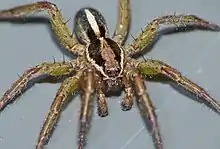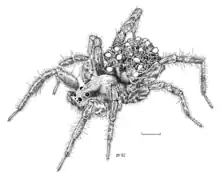Anoteropsis hilaris
Anoteropsis hilaris, commonly referred to as the garden wolf spider, is a species of wolf spider that is endemic to New Zealand.[1]
| Anoteropsis hilaris | |
|---|---|
 | |
| Scientific classification | |
| Kingdom: | Animalia |
| Phylum: | Arthropoda |
| Subphylum: | Chelicerata |
| Class: | Arachnida |
| Order: | Araneae |
| Infraorder: | Araneomorphae |
| Family: | Lycosidae |
| Genus: | Anoteropsis |
| Species: | A. hilaris |
| Binomial name | |
| Anoteropsis hilaris (Koch, 1877) | |
| Synonyms | |
| |
Taxonomy
Anoteropsis hilaris was first described three times in 1877 by Ludwig Carl Christian Koch in the same paper as Lycosa hilaris, Lycosa umbrata and Pardosa vicaria.[2] In the same year, Peter Goyen described Lycosa virgata and Lycosa taylori.[3] In 1899, Eugene Simon described Lycosa tremula.[4] In 1951, Carl Friedrich Roewer renamed L. virgata as Lycosa virgatella. In 1955, Roewer would transfer L virgatella and L. taylori to the Pardosa genus, L. tremula to the Arctosa genus and transfer L. umbrata to the Avicosa genus.[5] In 1960, Roewer would transfer A. tremula to the Arctosella genus. In 1964, Ray Forster described Lycosa subantarctica.[6] In 2002, Cor Vink placed Lycosa hilaris in the Anoteropsis genus and recognized all aforementioned names as synonyms of A. hilaris.[1]
Description
Anoteropsis hilaris is small with a body length of 4.9-11mm (male) or 4.9-11.8mm (female). The main body has a pale yellow stripe on the dorsal side running from the front of the head to about two thirds down the abdomen. The abdomen and cephalothorax vary in colouration, but are typically brown with darker colours near the medial stripe. The legs are also variable but are typically yellow-brown, but may also have green segments.[1]
The eggsacs have a pinkish tinge when first laid.[1]
Anoteropsis hilaris can be distinguished from other species of Anoteropsis by the morphology of its reproductive system.[1]

Distribution and habitat
Anoteropsis hilaris is widespread throughout both main islands of New Zealand and on some of New Zealand's smaller islands such as Stewart Island, Three Kings Islands, Snares Island and Auckland Islands. The spider occurs in grassland scrub habitats everywhere except in alpine zones.[1] A. hilaris is one of the most abundant predatory arthropods in New Zealand's agricultural ecosystems.[7]
Life history
Adults appear to have seasonal abundance, being most abundant from December to January (but can be found all year round). Eggsacs have been recorded from September to March, which are carried by the female.[1][8] The female carries the spiderlings, which have been recorded from December to March.[1]
References
- Vink, C. (2002). Lycosidae (Arachnida: Araneae). Fauna of New Zealand 44: 1-94.
- Koch, L. (1877a). Die Arachniden Australiens. Nürnberg 1, 889-968.
- Goyen, P. (1887). Descriptions of new spiders. Transactions of the New Zealand Institute 19: 201-212.
- Simon, E. (1899b). Ergebnisse einer Reise nach dem Pacific (Schauinsland 1896-1897). Arachnoideen. Zoologische Jahrbücher, Abtheilung für Systematik, Geographie und Biologie der Thiere 12(4): 411-437.
- Roewer, C. F. (1955c). Katalog der Araneae von 1758 bis 1940, bzw. 1954. 2. Band, Abt. a (Lycosaeformia, Dionycha [excl. Salticiformia]). 2. Band, Abt. b (Salticiformia, Cribellata) (Synonyma-Verzeichnis, Gesamtindex). Institut royal des Sciences naturelles de Belgique, Bruxelles, 1751 pp.
- Forster, R. R. (1964b). The Araneae and Opiliones of the subantarctic islands of New Zealand. Pacific Insects Monographs 7: 58-115
- Sivasubramaniam, W.; Wratten, S. D.; Klimaszewskl, J. (1997-01-01). "Species composition, abundance, and activity of predatory arthropods in carrot fields, Canterbury, New Zealand". New Zealand Journal of Zoology. 24 (3): 205–212. doi:10.1080/03014223.1997.9518115. ISSN 0301-4223.
- "T.E.R:R.A.I.N - Taranaki Educational Resource: Research, Analysis and Information Network - Wolf spider (Anoteropsis hilaris)". www.terrain.net.nz. Retrieved 2019-10-03.